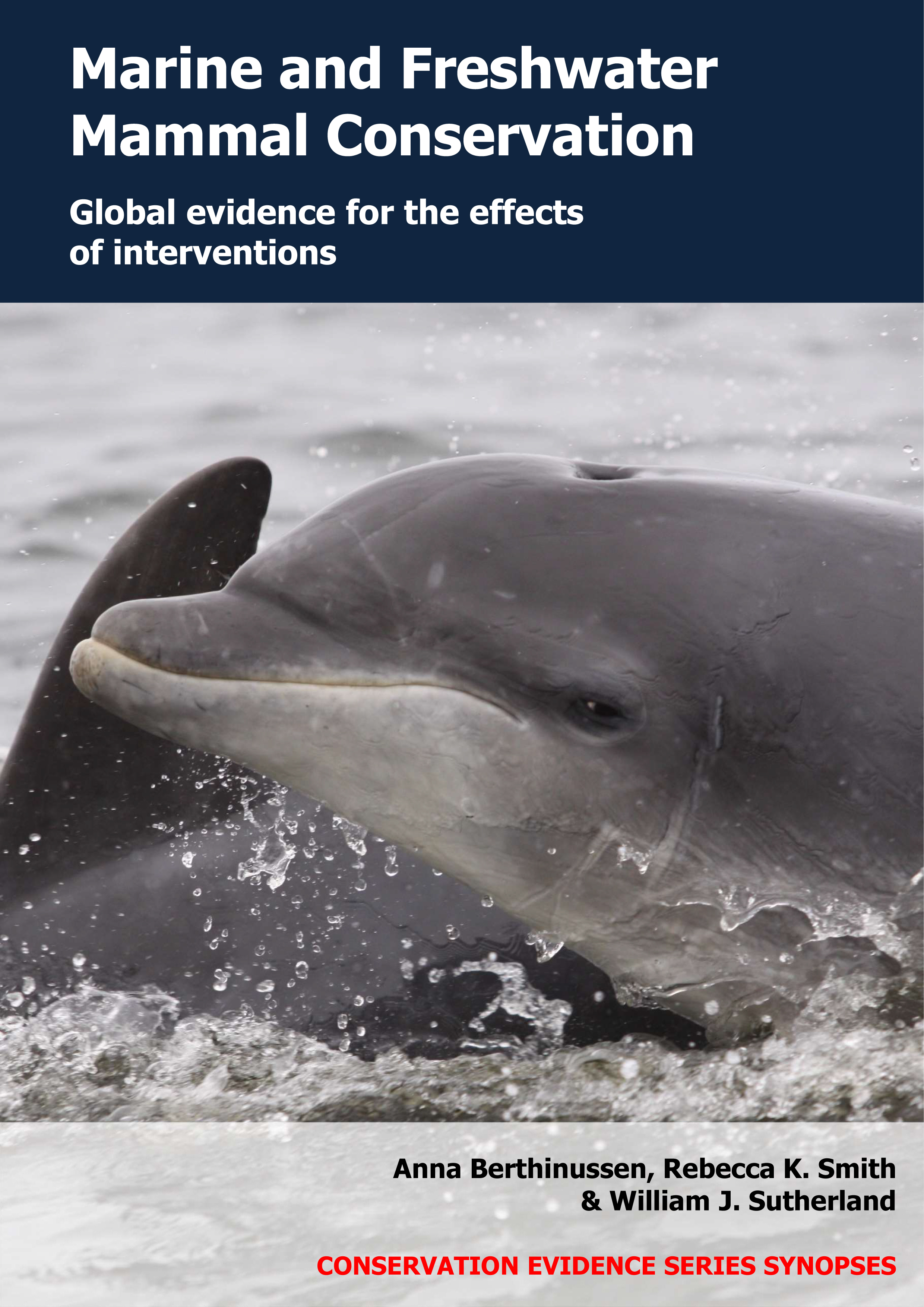Actions to conserve biodiversity
We have summarised evidence from the scientific literature about the effects of actions to conserve wildlife and ecosystems.
Review the evidence from the studies
Not sure what Actions are? Read a brief description.
Search for evidence
e.g. "frogs chytrid"
180 Actions found
Refine
Hide
180 Actions found
Download Actions
| 0 selected |
|
Order results by:
| Action | Effectiveness | Studies | Category | |
|---|---|---|---|---|
|
Set and enforce vessel speed limits Action Link |
Likely to be beneficial | 2 |
|
|
|
Set or improve minimum sewage treatment standards Action Link |
No evidence found (no assessment) | 0 |
|
|
|
Set regulatory ban on marine burial of nuclear waste Action Link |
No evidence found (no assessment) | 0 |
|
|
|
Switch off artificial lighting at wild fisheries Action Link |
Unknown effectiveness (limited evidence) | 1 |
|
|
|
Train tourist guides to minimize disturbance and promote marine and freshwater mammal conservation Action Link |
Unknown effectiveness (limited evidence) | 1 |
|
|
|
Translocate mammals away from aquaculture systems to reduce human-wildlife conflict Action Link |
Likely to be ineffective or harmful | 2 |
|
|
|
Translocate marine and freshwater mammal species before onset of impactful activities Action Link |
No evidence found (no assessment) | 0 |
|
|
|
Translocate marine and freshwater mammals to re-establish or boost native populations Action Link |
Likely to be beneficial | 4 |
|
|
|
Translocate or temporarily bring marine and freshwater mammals into captivity to reduce exposure to disease Action Link |
No evidence found (no assessment) | 0 |
|
|
|
Treat ballast water before release Action Link |
No evidence found (no assessment) | 0 |
|
|
|
Treat disease in wild marine and freshwater mammals Action Link |
No evidence found (no assessment) | 0 |
|
|
|
Treat wastewater from intensive livestock holdings Action Link |
No evidence found (no assessment) | 0 |
|
|
|
Use ‘bioremediating’ organisms to remove or neutralize pollutants Action Link |
No evidence found (no assessment) | 0 |
|
|
|
Use ‘mammal-safe’ nets to capture and release mammals trapped in fishing structures Action Link |
Unknown effectiveness (limited evidence) | 1 |
|
|
|
Use ‘soft start’ procedures to deter marine and freshwater mammals to reduce noise exposure Action Link |
Unknown effectiveness (limited evidence) | 3 |
|
|
|
Use a larger mesh size for fishing trap-nets Action Link |
Unknown effectiveness (limited evidence) | 1 |
|
|
|
Use a smaller mesh size for fishing nets Action Link |
No evidence found (no assessment) | 0 |
|
|
|
Use acoustic decoys to divert mammals away from fishing gear Action Link |
Unknown effectiveness (limited evidence) | 1 |
|
|
|
Use acoustic devices at aquaculture systems Action Link |
Trade-off between benefit and harms | 6 |
|
|
|
Use acoustic devices at cooling water intake structures Action Link |
No evidence found (no assessment) | 0 |
|
|
|
Use acoustic devices at renewable energy sites Action Link |
No evidence found (no assessment) | 0 |
|
|
|
Use acoustic devices on fishing gear Action Link |
Trade-off between benefit and harms | 33 |
|
|
|
Use acoustic devices on fishing vessels Action Link |
Trade-off between benefit and harms | 5 |
|
|
|
Use acoustic devices on moorings Action Link |
Trade-off between benefit and harms | 8 |
|
|
|
Use acoustic devices on moving vessels Action Link |
No evidence found (no assessment) | 0 |
|
Download Actions
| 0 selected |
|

Marine and Freshwater Mammal Conservation - Published 2021
Marine and Freshwater Mammal Synopsis
Watch this search
If you are familiar with RSS feeds, please click the button below to retrieve the feed URL:
RSS feed for this searchIf you are unfamiliar with RSS feeds, we would suggest reading this BBC article.
Unfortunately, due to the number of feeds we have available, we cannot provide e-mail updates. However, you could use tools such as Feed My Inbox to do this for you.
What are 'Individual studies' and 'Actions'?
Individual studies
An individual study is a summary of a specific scientific study, usually taken from a scientific journal, but also from other resources such as reports. It tells you the background context, the action(s) taken and their consequences.
If you want more detail please look at the original reference.
Actions
Each action page focuses on a particular action you could take to benefit wildlife or ecosystems.
It contains brief (150-200 word) descriptions of relevant studies (context, action(s) taken and their consequences) and one or more key messages.
Key messages show the extent and main conclusions of the available evidence. Using links within key messages, you can look at the paragraphs describing each study to get more detail. Each paragraph allows you to assess the quality of the evidence and how relevant it is to your situation.
Where we found no evidence, we have been unable to assess whether or not an intervention is effective or has any harmful impacts.





)_2023.JPG)














